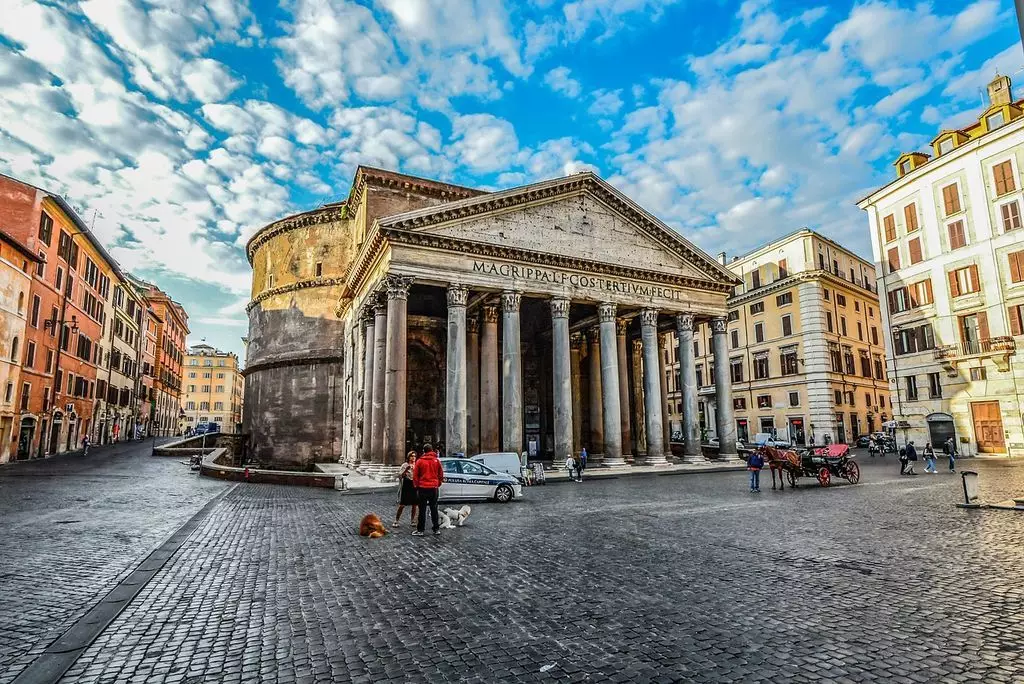
Pantheon Rome
Pantheon Rome – Info, Tickets, Opening Hours, and Travel Tips
Step inside the Pantheon and experience a masterpiece of ancient engineering. Known for its iconic dome — still the largest unreinforced concrete dome in the world — the Pantheon captures natural light through a central oculus that creates a magical atmosphere inside. A clever drainage system in the floor, preserved from ancient times, prevents flooding during rain. The famous painter Raphael and several Italian kings are buried here. Michelangelo, deeply impressed, once called the Pantheon the work of angels, not of men.
Don't miss the chance to visit this architectural wonder by night — the atmosphere is unforgettable and offers a completely different perspective.
How to Get to the Pantheon
Located in the heart of historic Rome, the Pantheon is easily reachable on foot or by bus. While there's no direct metro line, it’s just a short walk from other major landmarks like the Trevi Fountain or Piazza Navona.
Pantheon Opening Hours
The Pantheon welcomes visitors all year round, except on January 1st and December 25th. The last admission is 15 minutes before closing time.
| Opening Hours | |
|---|---|
| Monday | 9:00 AM – 7:00 PM |
| Tuesday | 9:00 AM – 7:00 PM |
| Wednesday | 9:00 AM – 7:00 PM |
| Thursday | 9:00 AM – 7:00 PM |
| Friday | 9:00 AM – 7:00 PM |
| Saturday | 9:00 AM – 7:00 PM |
| Sunday | 9:00 AM – 7:00 PM |
| January 1 & December 25 | Closed |
| Public Holidays (Weekdays) | 9:00 AM – 1:00 PM |
Entrance Fees for the Pantheon
As of July 3, 2023, entry to the Pantheon is no longer free. Adult visitors (25+) pay €5.00, while EU citizens aged 18–25 pay a reduced fee of €2.00. Visitors under 18 can enter free of charge.
| Ticket Type | Price |
|---|---|
| Adults (25+) | €5.00 |
| EU Citizens (18–25) | €2.00 |
| Children & Teens (under 18) | Free |
| Audio Guide | €10.00 |
Where to Buy Pantheon Tickets
You can buy tickets directly at the entrance, but be prepared for long queues, especially during peak hours. While tickets are theoretically available on the official website, the system is known to be unreliable. For a smoother experience, it’s best to book through external platforms that include an audio guide and fast-track access, letting you skip the lines.
How Long Are the Wait Times?
As the most visited building in all of Italy, the Pantheon sees over 7 million visitors a year. Wait times can be long, but usually don’t exceed 60 minutes — and with a fast-track ticket, you can skip the line entirely.
Are Guided Tours Available?
Absolutely! You can explore the Pantheon at your own pace with an audio guide, or opt for a guided tour led by an expert who will bring the history of the Pantheon to life.
BOOK AUDIO GUIDE Book Guided Tour
The History of the Pantheon
The Pantheon is more than just a beautiful building — it's a testament to the brilliance and endurance of Roman architecture. Its story begins in the 1st century BC, when the original Pantheon was commissioned by Marcus Agrippa, a close advisor and son-in-law of Emperor Augustus. A proud inscription on the front still reads: “M·AGRIPPA·L·F·COS·TERTIVM·FECIT”, meaning “Marcus Agrippa, son of Lucius, built this during his third consulship.”
However, this early structure was destroyed by fire, as was a second version built shortly after. What we see today is the third incarnation, completed under Emperor Hadrian between 118 and 128 AD. Interestingly, Hadrian chose to keep Agrippa's original inscription as a tribute to the first builder — a nod to Rome’s deep respect for its past.
At the heart of the Pantheon’s awe-inspiring design is its massive dome, still the largest unreinforced concrete dome in the world. The oculus — a nine-meter-wide circular opening at the top — acts as a cosmic spotlight, flooding the interior with daylight and connecting the temple to the heavens. The geometry, symmetry, and scale of the structure continue to astonish engineers and architects to this day.
Originally constructed as a temple dedicated to all Roman gods (Pantheon literally means “all gods”), the building was converted into a Christian church in 609 AD. Pope Boniface IV consecrated it as Santa Maria ad Martyres, a move that helped preserve it through centuries of religious change and political upheaval.
Over the centuries, the Pantheon has inspired countless artists, architects, and thinkers. The Renaissance painter Raphael chose it as his final resting place, and generations of Italian monarchs were also buried within its walls. Even Michelangelo, no stranger to architectural genius, reportedly said the Pantheon looked like it was built by angels, not by men.
Today, the Pantheon remains a sacred space, a historic monument, and a place of wonder — bridging past and present in the heart of Rome. Whether you’re an architecture enthusiast, history lover, or spiritual seeker, a visit to the Pantheon offers a profound and unforgettable connection to one of humanity’s greatest achievements.